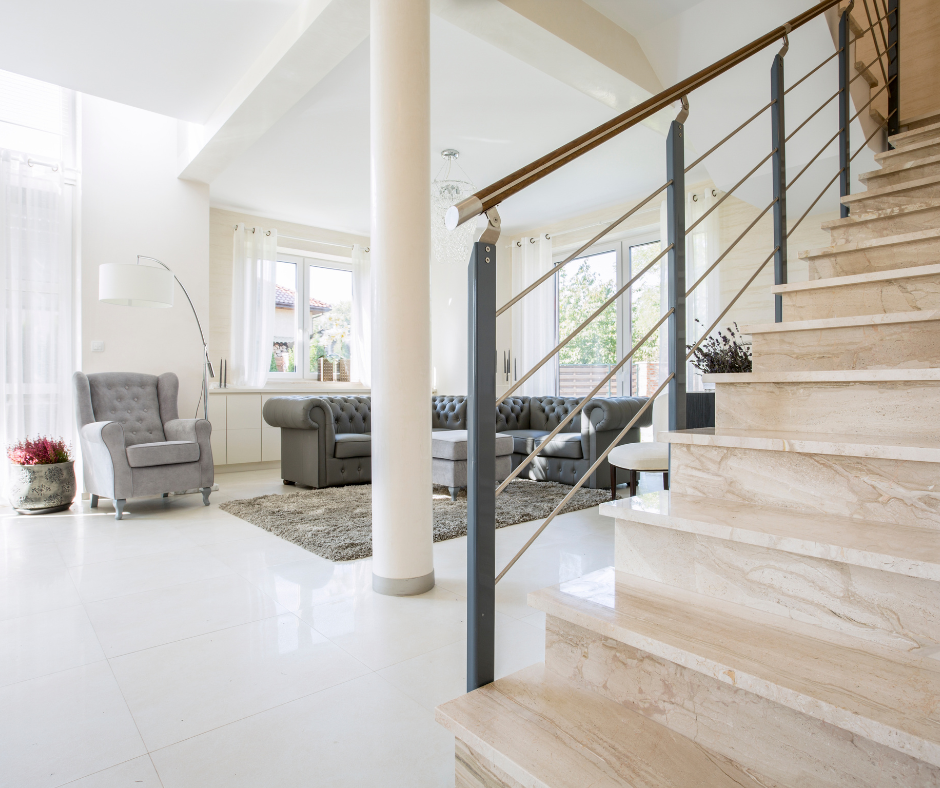Worried your stairs might not meet code?
You’re not alone.
Many homeowners—even the handy ones—aren’t sure what’s required when it comes to code requirements for stair tread overhang.
But getting it right isn’t just about passing inspections—it’s about keeping your family safe, your home stylish, and your DIY upgrades up to standard.
Let’s break it down so you know exactly what to do—and feel good doing it.
What Is Stair Tread Overhang?
Stair tread overhang, often called “nosing,” is the part of the step that extends slightly beyond the riser beneath it.
This seemingly small detail plays a big role in how your stairs function and feel.
It adds extra space for your foot, provides visual definition for each step, and helps prevent trips and slips—especially on the way down.
Whether you're working with hardwood, painted wood, or carpet stair treads, the overhang matters just as much for comfort as it does for safety.
Why Does the Overhang Matter for Safety?
The overhang isn’t just a design detail—it’s a built-in safety feature.
That slight extension helps:
-
Improve foot placement, especially while descending
-
Reduce risk of slips or stumbles
-
Define step edges clearly for kids, pets, and older adults
-
Create a smoother transition on carpeted stairs
That’s why the code requirements for stair tread overhang are included in building regulations: because they protect people with every step.
The IRC Guidelines: A Clear Breakdown
If you’re curious about what stair tread overhang codes require, here’s a straightforward breakdown from the International Residential Code (IRC):
Minimum Overhang
Each stair tread must project at least ¾ inch beyond the riser below.
This ensures enough landing space for your toes.
Maximum Overhang on Stair Tread
The maximum overhang on stair tread allowed by code is 1¼ inches.
Anything longer can pose a tripping hazard.
Uniformity Rule
Every step must have a consistent overhang.
The difference between the smallest and largest overhang in your staircase can’t exceed ⅜ inch.
Even small inconsistencies can throw off a person’s stride and balance.
Understanding Stair Tread Nose Overhang
The stair tread nose overhang is the rounded or bullnose edge on the front of the stair.
It’s designed to soften the look and feel of each step while improving safety.
This kind of overhang:
-
Prevents sharp edges from catching toes
-
Offers a more comfortable step surface
-
Makes the edge more visible—especially useful with carpet stair treads
-
Helps keep treads or carpeting in place without curling
Choosing a stair tread with a nose overhang is a smart upgrade, particularly if your home includes children or elderly family members.
Are There Any Exceptions to Overhang Requirements?
Yes.
There are exceptions to the stair tread overhang code for certain types of staircases:
Open Riser Stairs
If your stairs are designed with no vertical riser between treads (open riser), the code does not require an overhang.
The space beneath each step already provides visual separation and foot clearance.
Deep Treads (11” or more)
If your stair tread depth is 11 inches or more, you are not required to add an overhang.
The deeper tread gives you sufficient space to step safely.
Commercial or Custom Stair Designs
Some commercial or specialty staircases follow different sets of guidelines.
Always check local code rules if you're working on a non-residential project or unique layout.
Applying the Code in DIY Projects
Getting your overhang right might sound complicated, but it’s completely manageable—especially when you break it down step by step.
Here’s how you can apply the stair tread overhang code in your own stair project:
1. Measure Each Step
Use a tape measure to check the distance from the front of each tread to the riser beneath.
Make sure it falls between ¾" and 1¼".
2. Stay Consistent
Check for variation.
If any tread is more than ⅜" different from the others, it’s time to make adjustments.
3. Choose Rounded Edges
Whenever possible, select treads with a nose overhang.
The curved front improves safety, especially when used with carpet stair treads.
4. Select Code-Compliant Products
All Oak Valley stair treads are designed with IRC requirements in mind.
They fit securely, wear well, and add a touch of luxury to your space—without complicated installation.
Why Overhang Matters for Carpet Stair Treads
If you’re using carpet stair treads, having a consistent overhang makes the install much easier—and safer.
A uniform stair nose:
-
Gives each tread a clean line to follow
-
Makes carpet edges look even and intentional
-
Reduces bunching or curling over time
-
Makes steps visually clearer for safety
Plus, a well-fitted overhang helps the adhesive hold better, so your carpet treads stay in place and last longer.
Common Questions from Homeowners
Can I add an overhang to existing stairs?
Yes, you can use stair overlays or replace existing treads with options that include built-in nosing.
Oak Valley offers custom options for all stair shapes and layouts.
Do all materials follow the same rules?
Yes—wood, tile, and carpet all follow the same stair tread overhang code requirements.
It’s about dimensions and consistency, not material.
Is this hard to DIY? Not at all.
Our stair treads are designed for simple installation with peel-and-stick backing and helpful guides.
You don’t need power tools or a contractor.
What Makes Oak Valley Different?
We don’t just sell stair treads.
We create solutions that make your home feel safe, stylish, and completely yours.
Here’s how we help:
-
Custom sizing: Get stair treads made to fit your exact measurements—including overhang needs
-
Fast shipping: Made in Georgia, shipped straight to your door
-
$1 swatches: Test colors and textures before committing
-
Easy returns: Ordered the wrong size? We’ll help you make it right
-
DIY support: Clear installation tips and real people available when you need help
Final Thoughts
The code requirements for stair tread overhang might seem technical, but they’re really just common sense in disguise.
They help keep you and your family safe while giving your staircase the structure and polish it deserves.
By sticking to these standards and choosing products that are designed with safety and ease in mind—like our carpet stair treads—you’re not just checking off a box.
You’re investing in peace of mind.
And that’s something you’ll feel every time you take a step.
Steps to Success
Getting your stair dimensions right is one of the most practical and protective upgrades you can make in your home.
Whether you're building, replacing, or refreshing, let Oak Valley help you take the right steps—with confidence, comfort, and code compliance built in.
-
Website: https://oakvalleydesigns.com/
-
Phone: 706.331.0315
-
Email: info@oakvalleydesigns.com
-
Address: 30 River Ct SW Bldg E Cartersville, Ga 30120




